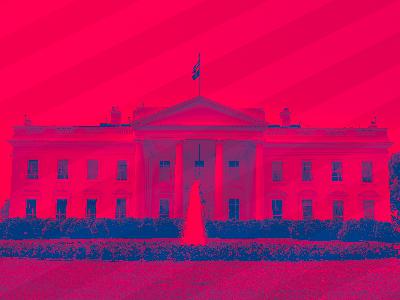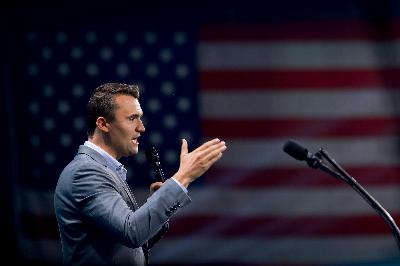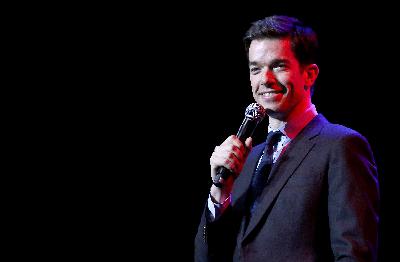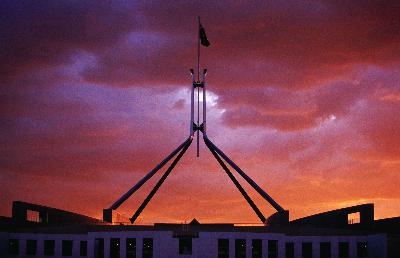Discover Full program podcast
Full program podcast

Full program podcast
Author:
Subscribed: 2,114Played: 31,607Subscribe
Share
© Copyright 2025, Australian Broadcasting Corporation. All right reserved.
Description
This podcast feed for The Minefield is closing soon because it's a duplication of our main program but you won't miss an episode. Search iTunes for The Minefield - ABC RN or use this RSS feed: http://www.abc.net.au/radionational/feed/6344904/podcast.xml
447 Episodes
Reverse
The politics of immigration has returned in recent months — and returned with a depth of feeling that suggests it never truly went away. It’s always there, lingering just beneath the surface of Western societies, waiting to be tapped into by politicians skilful (or brazen) enough to harness its power.So Donald Trump went to the 2024 presidential election excoriating his predecessor’s record on immigration and for “losing control” of the southern border control; by contrast, he promised the “largest deportation operation in American history”. In mid-September, as many as 150,000 people took to the streets in central London as part of the “Unite the Kingdom” rally organised by far-right activist Tommy Robinson. Demonstrators wrapped themselves in the Union Jack, waved St George’s flag and held aloft wooden crosses amid calls for “remigration” and other forms of mass deportation.Closer to home, also in August and September, a series of “March for Australia” demonstrations took place across Australia’s major cities against “mass migration” as the root of any number of social and economic problems: from housing shortages, food prices and traffic congestion to increased levels of social division and a declining sense of national “identity”.And as is invariably the case, there are politicians prepared to make the most of the social ferment. Leaving aside the surge in support for Nigel Farage’s anti-immigration Reform UK party, we can point to Senator Jacinta Nampijimpa Price’s recent comments about Indian migrants and Liberal MP Andrew Hastie’s blunt identification of post-pandemic immigration levels as “the real reason you can’t afford a home”.Conservative political parties across Western democracies have “won” the debate over “border control”. It has been the clear intention of centre-left parties to neutralise the politics of “irregular arrivals”. What’s left, then, is the debate over multiculturalism and levels of immigration.And yet this is dangerous political terrain. For however much researchers point to the economic benefits of immigration, or the lack of clear connection between international student numbers and rising house prices, or the historic success of Australia’s bipartisan commitment to multiculturalism, “fact-checking” cannot touch the underlying emotions to which anti-immigration rhetoric appeals. Moreover, one of the reasons anti-immigration rhetoric is so successful is the fact it is at once parasitic and opportunistic. As social researcher Rebecca Huntley recently put it, “Whatever the top anxiety people have at any one time, they will graft an anxiety about immigration on it.”Given the affective dimension of both social cohesion and anti-immigration rhetoric, is there a way of appealing to political emotions as a way of addressing these anxieties without giving way to their more insidious expressions?
In a remarkable column from 1944, George Orwell bemoaned the sheer range of social and political phenomena to which the label “Fascist” was being applied — to the point that he believed the word itself had become “almost entirely meaningless”. And while it conveyed little more than a term like “bully” would, “Fascist” nonetheless carried an emotional charge, a degree of opprobrium, that such an everyday word did not.For this reason, Orwell concluded, the label should be used both precisely and sparingly: “All one can do for the moment is to use the word with a certain amount of circumspection and not, as is usually done, degrade it to the level of a swearword.”During the first Trump administration, a debate broke out among historians and political philosophers as to whether what the United States was witnessing amounted to “fascism”. For some, the term was an accurate description of a political disposition and form of political expression which at once had deep roots in American history — reaching back even before the Ku Klux Klan of the 1920s and the “America First” phenomenon in the 1930s — and enjoyed certain family resemblances with the European movements with which we ordinarily associate the word. For others, calling the Trump administration “fascist” was either premature, a form of rhetorical overreach or a misdiagnosis.In many respects, that debate now seems quaint. For after the 6 January 2021 assault on the US Capitol and the various forms of executive action taken by Donald Trump in his second administration — including the extortion of universities, law firms and media companies, the use of masked ICE agents to detain and “disappear” people without due process, the deployment of the National Guard on the streets of American cities, and the targeted prosecution of political adversaries — that which was merely feared has now come to pass.But does this mean the description “fascist” should now be used freely as a way of characterising the Trump administration — the way “populism” was after 2016? Not only are there serious questions about the rhetorical efficacy of the term’s use (even if it is historically or politically accurate) or its ability to mobilise an electorate against a common democratic threat. There is also the prospect that the use of the term itself could provide a degree of licence, in the minds of some, to take matters into their own hands and engage in outright political violence.This points to a kind of two-fold paradox involving “fascism”. On the one hand, fascism is itself a paradoxical political phenomenon in the way it holds together seemingly incommensurable impulses. As José Ortega y Gasset famously remarked in 1927:“It asserts authoritarianism and organises rebellion … It seems to pose itself as the forge of a strong State, and uses means most conducive to its dissolution, as if it were a destructive faction or a secret society. Whichever way we approach fascism we find that it is simultaneously one thing and its contrary, it is A and not A …”On the other hand, while the term “fascism” could accurately convey the gravity of the situation facing an advanced democracy, the very use of the term could deepen the democratic dysfunction and thereby exacerbate the political conflict. Would we be well-advised, then, to follow Orwell’s advice and use the term only ever circumspectly and not as a rhetorical weapon against our opponents?Guest: Jason Stanley is Professor of Philosophy at the University of Toronto, where he is also the Bissell-Heyd-Associates Chair in American Studies at the Munk School of Global Affairs & Public Policy. He is the author of How Propaganda Works, How Fascism Works: The Politics of Us and Them and, most recently, Erasing History: How Fascists Rewrite the Past to Control the Future.
This week is the first ever “Minefield Mailbag”, where Waleed and Scott try to respond to what’s been on our listeners’ minds.The questions they take on cover such diverse topics as society’s obligations to self-professed “sovereign citizens”, whether NATO is to blame for Russia’s invasion of Ukraine, why “virtue signalling” may not be such a bad thing after all, and the discrete relationship between philosophy and gardening.If you’d like to submit a question for a future mailbag, or propose a topic for a future episode, you can send an email to theminefield@abc.net.au.
It would be hard to overstate the significance of Charlie Kirk within the conservative movement and in the Trump administration. By some reckoning, his influence and social media prominence were second only to Donald Trump himself.As the founder and face of Turning Point USA, Kirk was pivotal in driving Trump’s appeal among younger voters — particularly young men. And, indeed, his singular appeal was to have made a muscular, self-assured brand of conservative Christian nationalism appealing in a hyper-online age. Hence his podcast would come to enjoy the kind of online saturation reserved for few other “content creators”. The social media algorithm was Charlie Kirk’s vernacular.It would not be right, however, to call Kirk an “online influencer”. Instead, he was a MAGA evangelist, a charismatic figure in the full sense of the word. And like all charismatic figures, while he tried to instil belief in young people, he also came to be the object of their belief — they could derive confidence from his confidence, from his self-assertiveness, from his ability to answer his detractors. Which is why his willingness to engage with his opponents in front of large crowds at colleges and on university campuses was integral to his persona.It is certainly to Kirk’s credit that he engaged in frank debate with those who were offended by his strident political convictions. But the performative logic of these “debates” was not to convince so much as it was to “own”. The true audience were not those physically present. Which is to say, point of the debates was to be turned into “content”.This begins to approach the significance of Charlie Kirk for those who have been left devastated by his assassination. Quite apart from the inherent indecency and immorality of taking the life of a young husband and father, killing Kirk has been received as an attack on a belief system — with its intertwined religious, racial and political elements — that sees itself as already threatened by “enemies within”.Assisted by how increasingly prominent his own Christianity became in recent years, Kirk represents what “America” will look like when it is made “great again”. It is no wonder, then, that he is quickly becoming canonised as a MAGA martyr.Finding smug satisfaction in the death of Charlie Kirk is to allow oneself to fall outside the bounds of fundamental decency. Wishing to “right the record” of his immoderate, frequently bigoted rhetoric, after his death, in such a way that it makes it sound as though Kirk “had it coming”, is also utterly indecent. And while there is no virtue in performing grief that one does not feel, being contemptuous of those who are grief-stricken over Kirk’s murder is itself democratically corrosive.Indeed, one of the predicates of political violence is the inability to recognise the humanity in one’s fellow citizens, and to see them only ever as bearers of a particular ideology — as “abstractions”. And that’s what is worrying about this particular political moment. Once citizens are turned into ideological abstractions — whether they’re called “fascists” or members of the “radical left” — they can be sacrificed in the service of a greater cause. In this way, contempt or the abandonment of basic decency are the conditions of possibility of “categorical” violence.If contempt and indecency are the kindling, then an event like the assassination of Charlie Kirk could provide the spark that turns the United States’ current “cold” civil war into a theatre of political violence.
In August, Kate Evans and Cassie McCullagh from The Bookshelf on Radio National, teamed up with the indomitable Sophie Gee — Professor of English at Princeton University, Vice-Chancellor’s Fellow in the Humanities at the University of Sydney, and co-host of the podcast The Secret Life of Books — and Scott Stephens from The Minefield, to mark the 250th anniversary of the birth of Jane Austen (1775–1817).In front of a live audience at the State Library of New South Wales, the quartet discussed Austen’s innovative approach to fiction, why her novels are of such abiding interest to moral philosophy, the importance of “a room of her own” when writing, and her subtle critique of patriarchy, gender norms, slavery and religion.Finally, they reflect on three exemplary moments in Austen’s last three novels — Mansfield Park (1814), Emma (1816) and Persuasion (1818).This episode was originally broadcast on The Bookshelf on Thursday, 11 September 2025.
Whether it is in geopolitics or in social and personal relationships, the overweening desire to “save face” can have manifestly unjust and outright damaging consequences.Those who continue to languish under Iran’s oppressive regime take little comfort in Ayatollah Ali Khamenei being afforded the opportunity to shore up his public standing following the US missile strikes on its nuclear facilities. And Hannah Arendt correctly observed at the heart of the ‘Pentagon Papers’ a willingness on the part of the US government to lie to the American people about the status of the war in Vietnam, and thus to prolong an unwinnable and inhumane war, in order to protect “the reputation of the United States and its President”.When saving face is paramount to all other considerations, others invariably pay the price in order for the untrammeled supremacy of the ego to persist.But “ego” does not quite grasp the social complexity bound up with the concept of “face” — which suggests something closer to “honour” or a kind of thick social reputation, standing or prestige that is conferred by others, the loss of which is no mere bruised ego but a threat to one’s social existence.While this concept of “face” has partly been appropriated from Chinese culture, it nonetheless has roots in the ancient of honour/shame cultures of the Mediterranean and Asia Minor, and, as Kwame Anthony Appiah points out, finds expression fully as much in Western Europe and West Africa as it does in East Asia.Thus Immanuel Kant will warn about the moral dangers of “defamation” and of the intentional dissemination of scandalous information which, even if true, “detracts from another’s honour” and “diminishes respect for humanity as such … making misanthropy or contempt the prevalent cast of mind”. He concludes:“It is, therefore, a duty of virtue not to take malicious pleasure in exposing the faults of others so that one will be thought of as good as, or at least not worse than, others, but rather throw the veil of philanthropy [Menchenliebe] over their faults, not merely by softening our judgements but also by keeping our judgements to ourselves; for examples of respect that we give other can arouse their striving to deserve it.”Kant recognises that frequently the desire to humiliate another is not about their reproof, but about our own relative aggrandisement.Does this suggest that giving someone the ability to “save face”, even when they are found to be in the wrong, can function as both a rejection of the zero-sum logic that often prevails in honour/shame cultures (in which there is only so much social prestige to go around) and a constructive way of keeping them within a moral community?
There is something undeniably disorienting about the way AI features in public and political discussions.On some days, it is portrayed in utopian, almost messianic terms — as the essential technological innovation that will at once turbo-charge productivity and discover the cure to cancer, that will solve climate change and place the vast stores of human knowledge at the fingertips of every human being. Such are the future benefits that every dollar spent, every resource used, will have been worth it. From this vantage, artificial general intelligence (AGI) is the end, the ‘telos’, the ultimate goal, of humanity’s millennia-long relationship with technology. We will have invented our own saviour.On other days, AI is described as representing a different kind of “end” — an existential threat to human life, a technological creation that, like Frankenstein’s monster, will inevitably lay waste to its creator. The fear is straightforward enough: should humanity invent an entity whose capabilities surpass our own and whose modes of “reasoning” are unconstrained by moral norms or sentiments — call it “superintelligence” — what assurances would we have that that entity would continue to subordinate its own goals to humankind’s benefit? After all, do we know what it will “what”, or whether the existence of human beings would finally pose an impediment to its pursuits?Ever since powerful generative AI tools were made available to the public not even three years ago, chatbots have displayed troubling and hard-to-predict tendencies. They have deceived and manipulated human users, hallucinated information, spread disinformation and engaged in a range of decidedly misanthropic “behaviours”. Given the unpredictability of these more modest algorithms — which do not even approximate the much-vaunted capabilities of AGI — who’s to say how a superintelligence might behave?It’s hardly surprising, then, that the chorus of doomsayers has grown increasingly insistent over the last six months. In April, a group of AI researchers released a hypothetical scenario (called “AI 2027”) which anticipates a geopolitical “arms race” in pursuit of AGI and the emergence of a powerful AI agent that operates largely outside of human control by the end of 2027. In the same vein, later this month two pioneering researchers in the field of AI — Eliezer Yudkowsy and Nate Soares — are releasing their book, If Anyone Builds It, Everyone Dies: The Case Against Superintelligent AI.For all this, there is a disconcerting irony that shouldn’t be overlooked. Warnings about the existential risk posed by AI have accompanied every stage of its development — and those warnings have been articulated by the leaders in the field of AI research themselves.This suggests that warnings of an extinction event due to the advent of AGI are, perversely, being used both to spruik the godlike potential of these companies’ product and to justify the need for gargantuan amounts of money and resources to ensure “we” get there before “our enemies” do. Which is to say, existential risk is serving to underwrite a cult of AI inevitabalism, thus legitimating the heedless pursuit of AGI itself.Could we say, perhaps, that the very prospect of some extinction event, of some future where humanity is subservient to superintelligent overlords, is acting as a kind of decoy, a distraction from the very real ways that human beings, communities and the natural world are being exploited in the service of the goal of being the first to create artificial general intelligence?Guest: Karen Hao is the author of Empire of AI: Inside the Reckless Race for Total Domination.
In the middle of August, the Bendigo Writers Festival found itself at the centre of a firestorm after over fifty participants decided to withdraw — some claiming they were required to engage in a form of “self-censorship”, and others withdrawing in solidarity.Reports have it that, two days before the festival was due to open, a “code of conduct” was sent to those taking part in the one of the four La Trobe Presents panels, “urging compliance with the principles espoused in [the university]’s Anti-Racism Plan, including the definitions of antisemitism and Islamophobia in the Plan”. The code also asked participants to practice “respectful engagement” and “[a]void language or topics that could be considered inflammatory, divisive, or disrespectful”.For many of those due to take part in the writers’ festival, this code of conduct amounted to a demand for self-censorship over what they hold to be a “genocide” taking place in Gaza, and would prevent them from criticising the actions of the State of Israel, “Zionism” as an ideology and, by extension, “Zionists”.This is just the latest of a series of controversies surrounding Australian writers’ festivals — some of which pre-date the massacre of Israeli civilians on 7 October 2023 and the onset of Israel’s devastating military incursion into Gaza, but which have now intensified and been rendered even more intractable by those events.The conflict in Gaza has placed severe strain not only on the relationships between Australian citizens and communities, but also on our civic spaces and modes of communication: from protests on streets and demonstrations on university campuses, to social media posts and opinion pieces. Given that writers’ festivals intersect with each of these social spheres, it is unsurprising that they should prove so susceptible to the fault lines that run through multicultural democracies.Leaving the wisdom or effectiveness of “codes of conduct” aside, it is worth considering whether there are constraints inherent to public debate in a democracy — which is to say, forms of self-limitation and fundamental commitments that ensure the cacophony of conflicting opinions does not descend into a zero-sum contest.
This week the federal government’s much-anticipated, and just as hyped, Economic Reform Roundtable has gotten underway. Central to the agenda is how to boost national productivity — which is, roughly speaking, a way of measuring the resources needed both to produce certain goods and to be able to afford to buy certain goods.Put simply: greater efficiency leads to greater affordability and higher living standards. When the same amount of time, labour, investment and raw materials (‘inputs’) need to be expended in order to produce an even greater number of goods and services (‘outputs’), the inputs become more valuable even as the outputs become more affordable, leading to lower working hours and relatively higher standards of living.By contrast, anything that impedes efficiency reduces productivity. Unsurprisingly, then, the need to reduce regulation emerged as a central theme in the lead-up to the productivity roundtable — whether that means reforming environmental laws that slow down the housing approval process or reducing constraints on the development and deployment of artificial intelligence.However you cut it, AI is central to our current national conversation about productivity, efficiency and standards of living. And yet, even as AI represents a key to “unlocking productivity”, it also presents an imminent threat to employment itself. Modelling by Goldman Sachs found that, while AI could drive a 7 per cent boost in global GDP by 2030, this would likely come at the expense of 300 million full-time jobs worldwide.In other words, AI is the latest, and most severe, expression of what John Maynard Keynes termed, a century ago in “Economic Possibilities for our Grandchildren” (1930), “technological unemployment” — by which he meant “unemployment due to our discovery of means of economising the use of labour outrunning the pace at which we can kind new uses of labour”. AI is technology that will produce entire areas of economic activity where human labour is either wholly redundant or greatly reduced, leading to a paradoxical situation where the economy is thriving and unemployment is high.It’s perhaps not surprising that the possibility of a Universal Basic Income (UBI) is being mooted — including by the pioneers, purveyors and prophets of AI themselves — as a necessary remedy to the radical disruption of humanity’s relationship to work that is likely to transpire between now and 2030. What are the merits of such a proposal? Could this function as a radical alternative to our current system of conditional welfare, relying as it does on moralisation of work itself?
In March, an ABC Four Corners investigation detailed widespread instances of abuse, injury and neglect in childcare centres across the country. Just a few months later, in a climate of already heightened public awareness and media scrutiny, a series of deeply disturbing allegations came to light of child sex abuse in childcare centres in Victoria, New South Wales and Queensland.The nature and extent of these instances of neglect and abuse, as well as the fact they involved the most vulnerable among us, suggested a systemic problem in Australia’s $20 billion childcare sector — something that tougher regulation or a national register of childcare workers or improved child safety training or even CCTV cameras will not fully address.Put simply: the concern isn’t simply that a few ‘bad actors’ managed to slip through the regulatory cracks, but that something more thoroughgoing or pervasive is undermining the quality of the care and education being provided to young children. Interestingly, both the Education Minister, Jason Clare, and the Minister for Early Childhood Education, Jess Walsh, have implicated the profit motive itself as compromising the care of some providers. Walsh singled out “some repeat offenders who continue to put profit ahead of child safety”, and Clare has acknowledged that “overwhelmingly higher levels” of quality are found among the not-for-profit providers.The federal government has announced a series of measures that, it hopes, will restore the trust of parents and the public in Australia’s childcare system — two-thirds of which is comprised of for-profit companies that have benefitted greatly from the subsidies provided to parents by the government. One of these measures is the ability to strip unsafe early education and care providers of their eligibility for subsidised care.But it is government subsidies themselves that have fuelled demand in the first place, precipitating a rapid influx of stock-market listed companies hoping to reap their own share of the windfall. It’s a familiar story that has played out since the late-1970s: rather than running vital utilities or social services themselves, government delegates the provision of vital goods and services to “the market” into which it intervenes through funding or regulation. Michael Maron has termed this the advent of the “regulatory state”.But are there some social goods — which is to say, goods that are integral to the possibility of human flourishing — that should not be exposed to the perverse incentives afforded the market? As Andrew Hudson, CEO of the Centre for Policy Development, has pointed out: “For too long, early childhood education has operated as a private market — leaving governments with limited tools to manage quality, access, or safety across the system. That’s what needs to change.”Unless there is an overriding commitment to the wellbeing and flourishing of the children on the part of the organisation — as the animating principle or ‘telos’ of the organisation itself — what reason is there not to cut corners, to limit staff pay, to reduce overhead, to maximise efficiency, to do the bare minimum in order to approach compliance?When the wellbeing of children is made subordinate to the goal of profit, it is the children themselves who are worse off.You can read Luara Ferracioli and Stephanie Collins reflect on whether early childhood care and education are compatible with the profit motive on ABC Religion & Ethics.
At the end of July, there was a strange juxtaposition of events that seemed almost designed to highlight the fault-lines which run through the political, legal, economic and ethical responses to climate change.On 23 July, the International Court of Justice handed down a non-binding advisory opinion that climate change constitutes an “urgent and existential threat”, that nations have an obligation to prevent climate change, and that the “failure of a state to take appropriate action to protect the climate system … may constitute an internationally wrongful act”.Just days later, two former leaders of the National Party — Barnaby Joyce and Michael McCormack — used the first parliamentary sitting week to prosecute their plan to see Australia abandon its commitment to reach its net zero emissions target by 2050. Their claim is that consumers, particularly those in the regions, will be made to bear the cost for honouring a commitment that means precious little when compared to the world’s major polluters. Net zero is thus a masochistic policy that amounts to little more than “virtue signalling” on the part of those who will not have to wear the consequences.Others have argued, though not quite so stridently, that “net zero” has achieved a kind of talismanic status — a morally pleasing target that expresses a certain moral seriousness and cannot help but hurl opprobrium at those who raise questions as to how realistically it can be reached and who will have to bear the brunt of costs. And climate scepticism aside, Joyce and McCormack have at least brought to the fore the tension between appearance and reality which has motivated a sizeable number of companies to leave Australia’s carbon credit market altogether over concerns for its efficacy and integrity.There have long been concerns that “net zero” is more like an accounting tool (hence the language of “offsets” and “credit markets”) than a substantive measure to both reduce carbon emissions and remove carbon from the atmosphere on an enormous scale — for it is only such coordinated, collective action that can hope to mitigate peak global temperatures and slow warming trends. Which is to say, it is only such action that can rise to the call to “responsibility” envisioned by the International Court of Justice.What, then, would it mean for Australia to honour its commitment to “net zero”, in substance and not just symbolically? What are the mechanisms, beyond the transition to renewable sources of energy and the existence of a well-functioning carbon market, that should be countenanced?You can read an analysis by Garrett Cullity and Christian Barry of the criticisms directed at “net zero” on ABC Religion & Ethics.*Upcoming event:Thursday, 21 August 2025Still Turning Heads at 250: Jane Austen’s Enduring CharmABC Radio National’s The Bookshelf and The Minefield join forces with a literary scholar and the State Library of New South Wales.Jane Austen: charming? Sure, but also radical, political, sharp, witty, entertaining and — by the time she wrote her last three books — a professional writer. So what did this mean, in the context of her life and work? And how do we understand the way she approached stories of friendship, ambition, money, love, power and equality? Morality, making do, making fun? A special event presented by ABC Radio National and the State Library of New South Wales, to make sense of all this and more. With Kate Evans and Cassie McCullagh from The Bookshelf, Scott Stephens from The Minefield, and literary academic Sophie Gee.Where? Library Auditorium & GlasshouseWhen? Thursday, 21 August 2025What time? 6:00pm - 7:00pmAdmission: FREE, but bookings requiredNOTE: Entry via the Mitchell LibraryThis event is being recorded for later broadcast.You can register on to join us on Eventbrite.
On 24 July, French President Emmanuel Macron announced his intention to recognise a Palestinian state at the UN General Assembly in September, as part of France’s “historical commitment to a just and durable peace in the Middle East”. Just five days later, UK Prime Minister Keir announced that the UK, too, will recognise a Palestinian state in September:“unless the Israeli government takes substantive steps to end the appalling situation in Gaza and commits to a long term sustainable peace, including through allowing the UN to restart without delay the supply of humanitarian support to the people of Gaza to end starvation, agreeing to a ceasefire, and making clear there will be no annexations in the West Bank.”These announcements come at a pivotal moment. The humanitarian crisis in Gaza is worsening by the day, with the UNRWA Commissioner-General, Philippe Lazzarini, reporting that one in five children are malnourished and more than 100 people have died from starvation. Meanwhile, negotiations between Israel and Hamas that would see hostages returned and a durable ceasefire reached have broken down and there is little prospect of them resuming.It is important to note that, whereas in the past the prospect of recognition of a Palestinian state has been used as a way of getting representatives of the Palestinian Authority to meet certain conditions, here the threat recognition is being used to pressure Israel into abandoning its own intransigence.Even among those who are committed to a two-state solution, however, there remains some doubt as to whether recognition would materially change anything for Palestinians, at least in the short term. So what would be the point of bringing recognition forward in the peace process?
There are few things more peculiar to a person than their preferences. Why it is they enjoy one genre of music over another, or a particular artist within that genre but not others. Why they derive specific pleasure from a certain type of fiction (romantasy, say, or Scandinavian procedurals) whereas others (like Agatha Christie’s Poirot crime novels or dystopian sci-fi) leave them cold.And then there’s that whole undergrowth of what we might call “guilty pleasures”: low-brow books or formulaic television series or lowest-common-denominator movies that we secretly enjoy but would be mortified if anyone found out.Which suggests, of course, that the network of preferences we call “taste” most often has a class dimension to it. Having specific tastes, and finding certain things distasteful, signals our belonging to the social stratum that has learned how to appreciate those cultural objects. It’s not that taste is altogether emptied of its subjective dimension — its ability to evoke authentic feeling, real enjoyment — but rather inner appreciation is in a kind of performative dialogue with the expectations of others.And yet even within the realm of taste, there are subtle distinctions. Immanuel Kant one between “the taste of sense” (what is pleasant to me) and “the taste of reflection” (which may not be immediately enjoyable, and which may require effort or patience or instruction before yielding its treasures). According to Kant, what is truly “beautiful” is only available to the taste of reflection — a form of enjoyment that we want to enjoy with others.In our world of endless digital reproduction, we increasingly rely on recommendation algorithms to curate our encounters with culture — algorithms that work along the lines of, “If you liked that, you will probably like this …” Algorithms, in effect, attempt to make our preferences legible, which is to say, predictable, offering us more of the same in order to keep us interested and engaged.In this way, algorithms can only work at the level of what Kant called the taste of sense — they can operate along the lines of “likes” or “dislikes”.But algorithmic recommendations cannot read the subtleties of our preferences, they tend toward massification, and they rule out the possibilities of both aesthetic achievement — learning how to appreciate, even love, what we didn’t initially “like”.
In a justly famous 1910 essay titled “The Moral Equivalent of War”, the American philosopher William James rejected the “fatalistic view” that war is an inevitability between nations, and expressed his hope of “a future when acts of war shall be formally outlawed as between civilized peoples”.For all this, however, James confessed that he did not believe “peace either ought to be or will be permanent on this globe, unless the states … preserve some of the old elements of army-discipline”. He feared that, in the absence of the cultivation of certain martial virtues — “intrepidity, contempt of softness, surrender of private interest, obedience to command” — a “peace-economy” would ultimately devolve into a “simple pleasure-economy”. Hence his appeal to discover what he would call a “moral equivalent of war”:“If now — and this is my idea — there were, instead of military conscription, a conscription of the whole youthful population to form for a certain number of years a part of the army enlisted against Nature, the injustice would tend to be evened out, and numerous other goods to the commonwealth would remain blind as the luxurious classes now are blind, to man’s relations to the globe he lives on, and to the permanently sour and hard foundations of his higher life.”What William James is calling for, of course, is a form of national service — a mass mobilisation of young men (and it is, unquestionably, men that James has in view), not in order to engage in warfighting, but for the sake of nation-building. The cultivation of manliness and military discipline that would result, James hoped, would then form a kind of “cement” upon which peaceful societies could be built.It is a compelling vision, and resonates with calls in many quarters for the establishment of forms of compulsory national service and the restoration of rites of passage for young men — collective experiences meant to initiate them into adulthood, and prepare them for the responsibilities that come along with it. These calls are also arising at a time when the very concept of masculinity itself is shrugging off a degree of the shame or opprobrium it has accumulated (most often in the form of the adjective “toxic”), particularly under the aegis of the #MeToo movement.Indeed, one of the more conspicuous dynamics at work during the 2024 US presidential campaign was the relentless association of “liberals” or “Democrats” with weakness, enfeeblement, effeminacy, hysterical emotionality … whereas Donald Trump and his ilk were powerful, rebellious, virile, stoic — in a word, masculine. It was hardly coincidental that Trump made so many appearances at UFC events and on macho podcasts. In its own way, the 2024 US presidential election was restaging the ancient contrast between Sparta and Athens, between Rome and Greece.“Extreme fitness” content online, the almost religious significance of gyms and the iconography of the “swoll” male body does seem to point to a kind of rejection of the liberal “pleasure economy” in favour of the military virtues of “hardihood”, discipline, preparedness to struggle, “contempt of softness”.And yet this performative masculinity ultimately lives and thrives online — and as such, is not only narcissistic but eschews the “surrender of private interest” and “obedience to command” that William James believed needed to be cultivated in order to ward off self-directed egotism.If we accept that young men may be craving the restoration of a sense of honour, of pride even, to the concept of masculinity, can this be done without the performative egotism, without the contempt for “softness”, without the will to dominate, that seems so much part of online culture?You can read Samuel Cornell’s article “Welcome to the age of fitness content — where men train for battle without ever experiencing war” on ABC Religion & Ethics.
Could a stand-up routine ever rise to the level of “art” — the kind of performance that rewards multiple viewings, whose humour grows and deepens, which contains subtleties waiting to be discovered? A sketch certainly can. Just think of Abbott and Costello’s “Who’s on First?” from 1944, or the trial of Ravelli in the Marx Brothers’ Duck Soup from 1933, or Peter Cook and Dudley Moore’s “One Leg Too Few” from 1964. With each new viewing, the comedic timing, the precision and cleverness of the puns, the exaggerated physicality, the sheer virtuosity of the writing cannot help but surprise and delight all over again.But with most stand-up, the humour arises from a certain immediacy: the interaction between the material and the peculiarity of the times in which it is delivered, and between the comedian and the physical audience. The frisson that arises from that interaction, the shock or surprise the comedian is able to elicit, is hard to re-experience to the same degree.It stands to reason, then, that if a stand-up act was to endure as a piece of comedic art, it would most likely be performed by a comedian who cut his teeth while working as a sketch writer for a show like Saturday Night Live.Enter John Mulaney. There is something undeniably enduring, timeless even, about his Netflix special “Kid Gorgeous at Radio City”. It was recorded in 2017 — in the aftermath of Trump’s first election to the US presidency, when public bewilderment was still offset somewhat by the belief it wouldn’t last long — and won an Emmy for Outstanding Writing for a Variety Special in 2018.Mulaney’s act exhibits a strange sort of genius, though. It is obviously a piece of writing. Indeed, he explicitly references the act of comedic writing throughout the routine.Mulaney is also assiduously non-political — right up until the moment that he isn’t. It begins with a nostalgic nod: “I just like old-fashioned things. I was in Connecticut recently, doing white people stuff …” He makes reference to the oddity of coming across a gazebo that was “built by the town in 1863”: “Building a gazebo during the Civil War, that’d be like doing stand-up comedy now.”And then he embarks on a metaphor for the Trump presidency that has been hailed by many as genius: “Here’s how I try to look at it, and this is just me, this guy being the president, it’s like there’s a horse loose in a hospital …”The aesthetic connection between Donald Trump’s golden coiff and a horse’s mane is, of course, immediately pleasing. As is the invocation of something heedless thundering through a finely tuned environment. There’s the added benefit that Trump’s name is not mentioned once, and yet the entire simile works. The question is … why?
In a digital age, it’s all about “content”. The post or tweet or reel or video or pod is nothing without something in it that permits it to be shared, to circulate, to attract attention, to promote engagement. What matters is the fact of circulation, not the usefulness or accuracy or beauty of what is circulating.In other words, “content” is generated not to last, but merely to attract attention for the time-being; it is designed to be transitory without regard for either epistemic or aesthetic value; it merely fills the void left by the creation of digital platforms; it exists primarily to circulate, which is to say, to go viral; it reduces everything to “fodder”, regardless of the human dimensions or tragedy or seriousness or spuriousness of the story. The perfect encapsulation of “content” is the meme.The ethical and aesthetic problems this presents are not exactly new, but the scale and speed of the “content industry” — especially in a time of generative AI – invests them with a degree of urgency.
As soon as it was published in February 1974, Peter Benchley’s novel “Jaws” was a sensation and remained on the New York Times best-seller list for over ten months. It continued to loom large in the public consciousness when, just 16 months after its publication, a 27-year-old Steven Spielberg adapted it for the big screen.While “Jaws” was the third such best-selling novel to be made into a popular film by the mid-1970s (following Mario Puzzo’s “The Godfather” from 1969, and William Peter Blatty’s “The Exorcist” from 1971), nothing to date rivalled its commercial success and cultural influence. This had something to do with Universal Pictures’ television advertising campaign, as well as the decision to opt for nation-wide release rather than the staggered rollout which had been the norm. But there was something about the source material on which the film drew — designed as it was to both appeal to and induce a certain terror about swimming in the ocean, about venturing into an alien habitat where humans don’t belong — and the scheduled release date at the start of the summer holidays, that achieved a rare alchemy; a perfect recipe for mass appeal. And so the “summer blockbuster” was born.The genius of Carl Gottlieb’s script and Spielberg’s directorial vision was to pare back the sprawl of Benchley’s novel — its preoccupations with class tensions, political corruption, marital breakdown, economic decline, urban crime and pollution — and reduce the story to two central planks: a monster terrorising a small sea-side town, and three men united in the effort to kill it. The movie is divided almost exactly into these halves (unlike Benchley’s novel, in which the hunt for the shark is limited to last quarter of the book).For all this, however, it is not finally the monster that holds our attention throughout the film — the shark, after all, barely appears, and is most often suggested, by music, by the exposed dorsal fin, by the yellow barrels — but two profoundly human affects:the vulnerability of the town itself, represented powerfully by Amity’s precarious economy and the bodies of the shark’s preferred prey — young women and children;the humanity and unlikely comradery of the three men aboard the far-too-small boat (as Roger Ebert wrote in his 1975 review, the movie works “because it’s populated with characters that have been developed into human beings we get to know and care about”).Without question, the cultural terror over the shark, which had been reduced to a “rogue” killer, a mindless “eating machine”, is one of the legacies of the film, and the impetus behind a range of disastrous anti-shark public policies. But “Jaws” also manages to hold out other lessons — about the danger of putting other priorities over public safety, about the nature of “moral panic”, and about the humanity that is required to ensure genuine threats don’t bring out the worst in us.
On 12 June, Israel initiated a devastating series of strikes on Iran — the goal of which was evidently to diminish the nation’s increasingly problematic nuclear program and to “decapitate” the nation’s top military leaders and nuclear scientists. There is no doubt these attacks were meticulously planned and represent the culmination of a long-term strategy: to neutralise the threat posed by Iran and its proxies in Lebanon, Yemen and Gaza.The timing and urgency of the strikes, however, have puzzled many. After all, they came little more than a week prior to the scheduled latest round of talks between the United States and Iran on the future of the latter’s nuclear program. The precipitating event seems to have been the release of a recent report by the International Atomic Energy Agency (IAEA), which found that “Iran can convert its current stock of 60 percent enriched uranium into 233 kg of WGU in three weeks … enough for 9 nuclear weapons”, and that “Iran is undertaking the near-final step of breaking out, now converting its 20 percent stock of enriched uranium into 60 percent enriched uranium at a greatly expanded rate”.Such findings would certainly have been central to US-Iran talks. But they were taken by Prime Minister Benjamin Netanyahu as posing a clear and imminent threat to the State of Israel, and therefore as justifying a preventive attack.Iran then unleashed a series of missile strikes of its own, citing justification on the grounds of “self-defence”. We have, in other words, two nations claiming to be acting in self-defence. But this isn’t peculiar to this specific conflict between historically hostile nations. Prior to the 2003 invasion of Iraq, the United States asserted a right to “pre-emptive self-defence”. Vladimir Putin justified Russia’s invasion of Ukraine in 2022 as an act of “self-defence” against a future attack.“Self-defence” thus seems to have become a legally and politically promiscuous term, and can thus be used to justify actions in which no imminent threat is present and for which alternatives are available. What, then, are the legal and philosophical limits to claims that one is acting in “self-defence”, particularly when that entails pre-emptive violence?
Between 1996 and 2022, for all but a brief and tumultuous six-year hiatus, the Coalition has governed Australia. Over this period, not only did the Liberal and National parties dominate federal politics, they defined the terrain upon which the political contest itself would be fought. On any number of policy fronts — from border security and immigration through to taxation, fiscal management and the US alliance — the Coalition staked out what would constitute the new political “centre”.But over the last two federal elections, the Coalition has seen its numbers in Parliament dramatically reduced — losing more than 30 seats to Labor and Teal independents, nearly all of them from Liberal ranks.It was hardly surprising, then, that the Coalition would find itself in jeopardy. After a brief separation, the Liberals and Nationals decided to carry on together. But the underlying tensions between the Parties remain. And yet these tensions are perhaps not as significant as those within the Liberal Party itself:between Liberal members/preselectors and the majority of Liberal voters;between the ideologically liberal and philosophically conservative forces;between the political moderates and aspirational multiculturalists, on the one hand, and those wanting to emulate the more extreme, divisive politics of the likes of Donald Trump, on the other.A divorce from the Nationals could have presented a welcome opportunity to resolve the Liberal Party’s own internal tensions, its lack of identity, its philosophical incoherence. Has the mended political relationship now made that impossible? During an extended period in opposition, can the Liberal Party fashion a truly Australian version of conservatism — one that eschews the more divisive, atavistic, bellicose traits that define it elsewhere?
It is a problem many people increasingly feel they can neither avoid nor ignore: we could characterise it as the problem of loving the art, but being unsettled by the behaviour or the beliefs of the artist who created it.This is a perfectly serviceable way of grasping the outline of the matter, but, on further reflection, it fails to get to its heart. For it’s not that we are merely put off by or disappointed with the artist — as though they have somehow failed to live up to an ethical ideal or have adopted a way of living that is a bit too outré for our liking.What is at issue is not so much disappointment as it is betrayal: we’ve come to know something about the artist so distressing that it cannot help but plunge us into a state of either deprivation (we still value the art, maybe even love it, but no longer know how to enjoy it) or dissonance (we go on pretending that what is essentially private doesn’t matter, and that the art can continue to be enjoyed in its own right). In either case, we are left longing for a lost innocence when we did not know what we now know.Whatever it is that ruins our appreciation of these artists and intellectuals, it is something that threatens to permeate the whole. Call it a kind of monstrousness. In her book Monsters: A Fan’s Dilemma, Claire Dederer perfectly captures the affective dimension of the dilemma concerning great artists:“They were accused of doing or saying something awful, and they made something great. The awful thing disrupts the great work; we can’t watch or listen to or read the great work without remembering the awful thing. Flooded with knowledge of the maker’s monstrousness, we turn away, overcome by disgust. Or … we don’t. We continue watching, separating or trying to separate the artist from the art. Either way: disruption.”It would be a mistake, however, to see the problem of “tainted artists” as just an ethical problem — like wearing affordable clothes that are manufactured under exploitative conditions, or eating chocolate that is not ethically sourced, or buying cage eggs, or a principled refusal to eat meat that otherwise tastes good. It is also an aesthetic problem. Because knowing what we know causes us to see the work differently.You can read an excerpt from Anna Funder’s book Wifedom, on George Orwell’s domestic monstrousness, here.

























i can't do itunes 😑